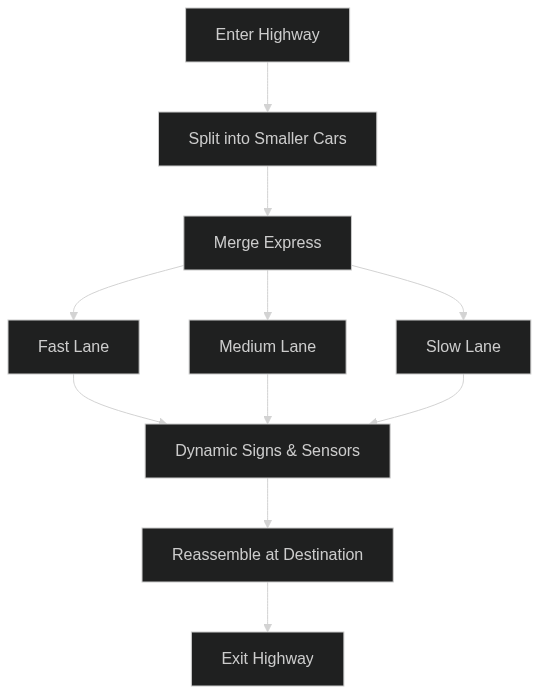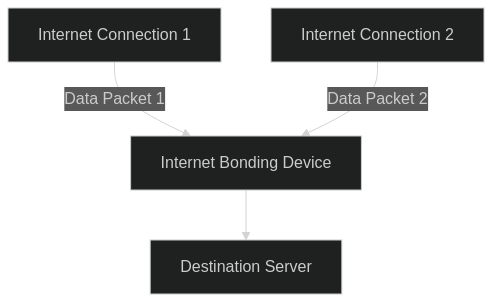Quick explaination of Internet Bonding
What is Internet Bonding and what are it’s benefits?
Imagine you’re driving on a busy highway. Each lane represents a separate internet connection: one for your home Wi-Fi, another for your mobile data, and a third for a wired ethernet connection. These lanes, like your internet connections, have different speeds and capacities.
Now, think of internet bonding as a special highway section, let’s call it the “Merge Express.” This section allows you to combine all the lanes into a single super-wide lane. Here’s how it works:
- Lane Combination: As you enter the Merge Express, your vehicle (data) is split into smaller cars (packets of data). These cars represent the data you want to send or receive.
- Distributed Traffic: The Merge Express has multiple lanes within it, just like your original lanes. Each car (packet) can take a different lane, distributing the traffic evenly.
- Efficient Routing: Along the Merge Express, there are dynamic signs and sensors. These signs determine the best route for each car based on traffic conditions. If one lane is congested (slow internet), your cars automatically switch to a faster one.
- Reassembly at Destination: Finally, as you exit the Merge Express, all the cars (packets) reassemble to form your complete vehicle (data) at their destination.
So, just as the Merge Express combines different lanes into a single, efficient roadway, internet bonding combines various internet connections into a faster and more reliable data transmission path. It ensures your data gets to its destination quickly, even if some lanes (internet connections) are slow or congested.
📖 Overview: Internet bonding is a groundbreaking technology that has transformed the landscape of internet connectivity. It’s not just a buzzword; it’s a method that combines multiple internet connections to create a single, more reliable, and faster pipeline for data transmission.
The Anatomy of Internet Bonding
🌐 Definition: Internet bonding involves merging multiple internet connections into a single virtual connection.
📦 Data Packets: In the digital realm, information is transmitted in the form of packets, which are the fundamental building blocks of internet bonding.
🛠 Mechanism: The core of internet bonding revolves around the intelligent distribution and reassembly of these data packets.
Internet Bonding Diagram
The Technical Grit: How It Works
📤 Packet Segmentation: The process begins with breaking down large files or data streams into smaller, manageable packets.
🔄 Packet Distribution: These packets are then distributed across the available internet connections, making efficient use of the combined bandwidth.
🎯 Packet Routing: Each packet may follow a different route to reach its final destination, depending on the current load and health of each connection.
🕒 Packet Reassembly: At the destination, these packets are meticulously reassembled to reconstruct the original data.
Advantages of Internet Bonding
🚀 Speed: The most apparent advantage is the substantial increase in speed. By combining multiple connections, you effectively add up their individual bandwidths.
🛡 Reliability: With multiple connections in play, if one goes down or experiences issues, the others remain operational, ensuring uninterrupted connectivity.
🌍 Geographical Flexibility: This is particularly valuable in areas where a single Internet Service Provider (ISP) might not offer sufficient coverage or speed.
Real-World Applications
🎥 Streaming: Internet bonding is a godsend for streamers who demand high upload speeds, ensuring smooth and uninterrupted broadcasts.
🚗 Vehicles: In moving vehicles like trains or buses, internet bonding can provide more stable connectivity, catering to passengers’ online needs.
🏢 Enterprise: Businesses often require robust, fail-safe internet connectivity, and bonding can provide just that, ensuring uninterrupted operations.
Challenges and Solutions
🤔 Complexity: One of the primary challenges of internet bonding is its complexity in terms of setup and management.
🛠 Solution: Thankfully, companies now offer user-friendly bonding solutions that handle all the technical intricacies behind the scenes, making it accessible to a broader audience.
Economic Aspects
💵 Cost: While internet bonding is effective, it’s not free. Multiple internet subscriptions need to be maintained to take full advantage of this technology.
📈 ROI: However, the return on investment can be substantial, especially for businesses reliant on consistent, high-speed internet, justifying the initial costs.
📌 Summary: Internet bonding stands as an innovative technology that brings a plethora of advantages, ranging from significantly increased speed to unmatched reliability. It’s a technology that’s well worth the investment for anyone who depends on a stable and fast internet connection.
Future Directions
📈 Big Data Analytics: Future advancements may include the integration of big data analytics to optimize the algorithms controlling packet distribution, further enhancing performance.
🤖 AI and Machine Learning: These technologies could be leveraged for predictive management of internet connections, foreseeing potential downtimes and automatically rerouting data, thus ensuring uninterrupted connectivity.


